
GRAY’S BEST awards are anticipated by longtime readers of Gray’s Sporting Journal and coveted by hunting and angling manufacturers. The reason? GRAY’S BEST has a tradition of authentic sincerity. Many sporting magazines print an end-of-the-year roundup of new products. Gray’s publishes a distinguished selection.
Our editors cover specialized areas of expertise and experience—Angling, Shooting, Apparel, and Accessories—and select gear that not only makes a good first impression but continues to measure up during repeated use. We make independent choices, absent encouragement and incentive from the manufacturers. GRAY’S BEST winners deliver on the claims of their makers and, further, come through with just a bit more, an extra something that triggers a certain feel, remembrance, or aesthetic that can be defined only as . . . satisfying. Much like Gray’s itself.
Angling

CF Burkheimer Vintage 6139-4 Spey Rod
If you live in the Northwest and fish for steelhead with two-handed rods, the name Burkheimer has always been associated with sweet sticks and soulful casting strokes that deliver pretty loops by anglers who still want to catch fish on or near the surface while swinging traditional flies. The talk returns again and again to the “Burkie feel”—shorthand for a progressive action that Kerry Burkheimer has, for decades, put into all his rods, both single- and double-handers, but for reasons far more technical than I’ll ever understand seems to have reached the apex of sophistication in these longish, lightish Spey rods. When I visited the Burkheimer shop in Washougal, Washington, to pick up my Vintage 6139- 4 ($1,295), I was blown away to discover that the entire manufacturing process—design, blank fabrication, hand-turned reel seats, the works—all takes place in-house; Burkheimer and his small crew of talented craftsmen fashion these exquisite rods in the style of luthiers or wooden boatbuilders from ages past. Besides casting like a dream, even in my untrained paws, the 6139-4 features elegant detailing from butt to tip, all of it pointing to a level of workmanship that seems to trans- late somehow into those long, soft deliveries that straighten the leader and immediately set your muddler to waking. I may not travel the world for sea-run fish, but in my neck of the woods, my Burkheimer two-hander makes me feel—and sometimes fish—like a real guy. www.cfbflyrods.com

Ross Reels San Miguel Fly Reel
For nearly 50 years now—almost as long as I’ve been in the game—Ross Reels has been designing and manufacturing fly reels that have earned a reputation for performance, dependability, and the sort of traditional or old- school styling that makes so many of us pleased to still recognize the world we live in today. It should come as little surprise then that Ross has chosen to reintroduce an updated version of the iconic San Miguel ($595), a reel found for decades on trout rods throughout the West. The styling is just as we remember it—solid back frame with easy-to-grab drag knob and flower-petal porting on the spool, all of it black and glossy, as familiar as khaki slacks and lapstrake boat hulls painted white. The handle’s been “updated,” fashioned out of resin-impregnated canvas Micarta, a material developed over a hundred years ago, as durable as Bakelite but with the texture of Tufnol blocks. The arbor has been oversized, as well, easier for retrieving line and less apt to leave memories of the spool spiraling through your rod tip. A trout reel may or may not actually need a sophisticated drag system, but the new San Miguel has just that, with a wide range and smooth start-up, features I appreciated all spring while fighting Deschutes River redsides heavy with salmonfly nymphs. www.rossreels.com
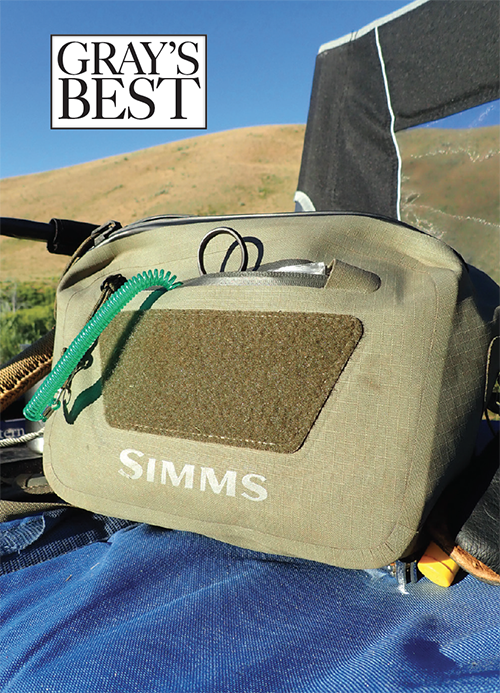
Simms Dry Creek Z Hip Pack
The search for comfortable and efficient ways to carry the too-many gewgaws most fly anglers feel they need on the water is probably as old as the sport itself. Worse, the prospect of stumbling upon the perfect design seems as unlikely as finding the perfect boat. Demands in my own fishing have also often included schemes to keep things dry; bouncing around in the surf, or up to my navel in a steelhead river, I view pockets and pouches as a rule-of-thumb safety governor on wading depth—until the moment I notice I’m carrying flooded fly boxes once again. Finally, however, our good friends at Simms have fashioned a fully submersible option, the Dry Creek Z Fishing Hip Pack ($200). I use mine everywhere—as a daypack for backcountry trouting, a pouch for flies, and an extra spool on neighborhood steel- head rivers, and when I hop over the gunwales to explore a stretch of remote Baja surf. The pack rides comfortably on a wide cushioned waistband and over-the-shoulder strap; the main pouch zipper mimics the watertight seal of a ziplock bag. Size and organizing compartments are pleasingly minimal: this is a pack for when you’ve narrowed your choices to a couple of fly boxes, the usual assortment of tippet and tools, perhaps a water bottle or an extra spool—all of which you expect to find dry even on discovering your boot soles have lifted free from solid ground. www.simmsfishing.com

Sage Trout II 490-4 Fly Rod
I often treat with disdain suggestions that I might need any rod besides the 9-foot 5-weight I carry for trout fishing. But on a recent trip that included backpacking into a small wilderness river, two days on another meadow stream cast- ing size 6 hoppers, and then a final day on a rambunctious tailwater swinging Muddler Minnows for trophy rainbows, I delighted in the all-around capabilities of the Sage Trout LL ($800), mine a 9-foot 4-weight that seemed capable of every manner of hijinks I might put it through. Sage offers all sorts of technical jargon for what it calls its new Konnetic HD Technology, the gist of which describes the increasingly refined use of graphite-resin composites we expect from innovative rod makers. In this case, the technology also translates into that sweet progressive action so many of us are happy to return to after years of fast-action rods made to deliver flies at distances few of us can actually fish effectively for trout. The Trout LL features the fine detailing and finish work we expect from a manufacturer with Sage’s reputation; the 490-4 has the giddyap of a rod designed to cast heavier lines and bigger flies, while proving delicate enough to deliver small drys close and still put the screws to big fish in ugly currents while protecting, in most cases, undersized tippets. I never thought I’d say this about a 4-weight, but the Sage 490-4 Trout LL may well become my go-to trout rod. www.sageflyfish.com
Shooting

GPO RangeTracker 1800 Rangefinder
Remember when rangefinders were bulky, heavy, required programming like a computer, offered unwanted features that only got in the way of the feature you did want to use (measuring the distance to that big whitetail), and used batteries that died just when you needed them most? Oh, and which cost an arm and a leg? Those days are past: Meet the newest rangefinder from German Precision Optics (GPO)—the RangeTracker 1800 ($400). It fits in a pocket, weighs next to nothing, and is easy to use. If you want them—but only if you want them—it offers sophisticated features such as measuring angle up or down and giving “true” range. Its 6X magnification and coated lenses make its images sharply defined, and it’s usable in low light (dawn and dusk) when the big guys typically appear. Its ranging capability is astonishing: From 6 to 1,800 yards. Now for the delicate part. The company website talks about its use in “long range hunting” out to that distance, which no ethical hunter would attempt, and we would not dream of encouraging. However, it has been our experience that the longer distance you can measure accurately, the better—and just because you can see that the big bull elk is 1,600 yards away does not mean you have to take a shot. It has also been our experience that a 1,600-yard rangefinder is more accurate and dependable at shorter distances than a lesser rangefinder. A bargain at the price. www.gpo-usa.com

GPO RangeGuide 2800 10×50 Binocular
This is the first time in the quarter-century since we began awarding GRAY’S BESTS that we have given two to the same company in the same category in the same year. German Precision Optics (GPO) warrants it because its RangeTracker (above) and RangeGuide binocular ($1,700) are so good, we couldn’t decide between them. Finally, we chose both. The binocular is noteworthy on several points. If memory serves, the first binocular to incorporate a rangefinder came out around 1995. It was bulky, heavy, and hideously expensive but of extraordinary quality and undoubtedly useful. Alas, you needed a Sherpa to carry it for you. Around the same time, a rangefinder–riflescope was offered by a different (also Teutonic) optics company. Same problems, except this monster was attached to your rifle. The optics world has come a long way since then, and today, having a two-in-one binocular–rangefinder is no longer either prohibitively expensive or unbearably inconvenient; witness the new GPO RangeGuide. It combines superb optical quality with usable magnification at a price that does not cause nosebleeds. It’s handy enough for backpacking in the mountains, and the magnesium body ensures durability. It has a 3,000-yard ranging capability, and can do other things like measuring angles up or down, and ambient temperature (useful for longer shots), and a “scan” mode that give three readings a second. These features are there if you need them, but not obtrusive if you don’t. www.gpo-usa.com

Filson Mesh Game Bag Vest
The Filson tin cloth shooting vest is as much a part of American wing shooting lore as the Winchester Model 12 and, as it turns out, much longer lived. It has been around at least since the 1930s. In the 1980s, the company ran a series of ads showing a well-worn vest that had been handed down from grandfather to father to son, and was still going strong. I have one I bought back then, and am wearing it still. You may be wondering, then, why such a venerable item is getting a GRAY’S BEST when the award is intended for new products. The reason is that in recent years Filson has expanded the line, offering the vest in different materials. The new one this year is the “mesh” vest ($145)—cooler for warm weather but with all the other desirable features: game bag, shell pockets in front, and expandable belt and straps that mean you can wear it over anything from a short-sleeved shirt to a Filson mackinaw. This one has the blaze-orange mesh and pocket flaps in front, which are invaluable. Like the original, it has no sharp edges or sawtooth zippers to scratch Ol’ Betsy’s lovely walnut. For the record, there are now about eight variations on that original tin cloth vest with game bag that was celebrated in those ads 30 years ago. The only problem this presents is deciding which one to buy. Oh, what the hell. Buy two. Or three. You may have another grandson. www.filson.com
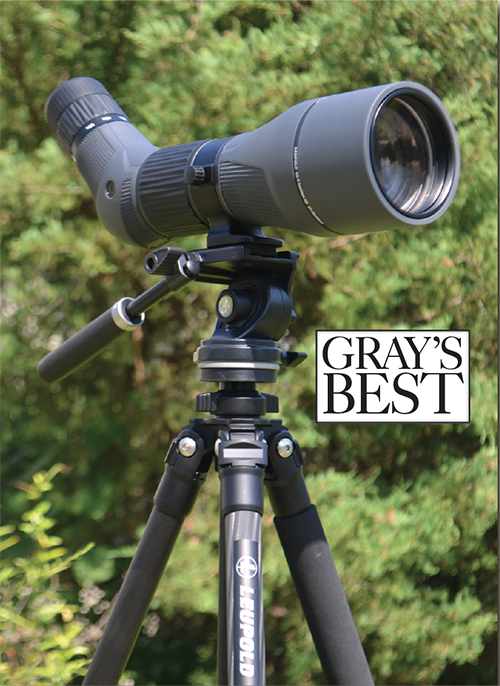
Leupold SX-5 Santiam HD 27–55×80 Spotting Scope
The Santiam line of optics from Leupold & Stevens is its entry into rarefied air where a scope or binocular costs more than you paid for your first car. Unlike that first car, however, you will still be using your Leupold Santiam HD spotting scope ($2,340) decades from now, unless your grandson has wheedled it out of you in the meantime. Leupold has always been known for the optical quality and durability of its made- in-America riflescopes but has traditionally gone a different direction with binoculars, spotting scopes, and similar ancillary equipment. Big-name German and Austrian optics makers owned the high-end market for those essentials from the 1980s onward. Now, with its Santiam line, Leupold is making a concerted effort to reestablish itself as the all-in-one optics maker for hunters who climb high and travel far. The Santiam line (and it is a line, with binoculars as well) is intended to face off against the big European names on their own turf. Aside from the usual fog-proof, shockproof features, Leupold goes into great detail about the glass, the coatings, the maximum abrasion resistance, and light-gathering qualities. It features something called Twilight Max HD Light Management System, which promises an extra 30 minutes of viewing time at dawn and dusk. Not knowing quite how to measure that, I simply took it out and watched a bunny under a bush at a hundred yards until it was too dark to see my hand in front of my face. Seems to work. www.leupold.com
Apparel

Simms Dockwear Jacket
Simms has built its business and reputation by keeping wading anglers dry. The company’s new Dockwear line, however, is designed to keep you in casual comfort on dry land. The line includes shirts, pants, hats, totes, and a vest, but it’s the quilted Dockwear Jacket ($200) that stands out most. It comes to you looking and feeling as though it’s been a favorite garment for years, worn from days and chores in the woods or the coat you keep in your truck for days when the weather takes a cool turn. The jacket features a Cordura shell for abrasion resistance, and a flannel lining to fight off the chill. In addition, the shell and sleeves are fortified with lightweight insulation, 60 and 40 grams respectively, for warmth that will be sufficient for all but the coldest months. For storage and comfort, the jacket has five pockets—two on the chest with button closures, a zipper pocket on the inside for a phone or wallet, and two handwarmer pockets that are deep and lined with flannel, which is a nice, warm touch. The Dockwear coat features a button-down front closure. All the buttons are ensconced in soft rubber, which makes them easier to operate with cold fingers. The jacket is also available in a hooded model ($250), which lacks the quilted outer shell. Both models are available in colors dark bronze or carbon. www.simmsfishing.com

Zamberlan Wasatch Boots
Emilio Zamberlan had a great passion for exploring the mountains near his home in Pievebelvicino di Torrebel- vicino, Italy, but he didn’t have proper footwear. In 1929, he and his wife, Maria, began making their own. He also forged a friendship with Vitale Bramani, the founder of Vibram—a mutually beneficial relationship that is still strong. From its humble beginning, Zamberlan now exports to more than 50 countries but still makes use of the original factory. And to this day, it’s all in the family, run now by Emilio’s niece and nephew, Maria and Marco. The company’s reputation is on firm standing, largely due to its penchant for using only the finest materials. For example, the Wasatch ($450), a boot designed for western big-game hunting, features an upper of thick-cut nubuck leather (the tougher, outer layer of calf- skin), a Vibram sole, and Gore-Tex membranes on the inside. In terms of performance, the outsole is beefier than previous offerings and yields greater stability and a larger footprint for better traction. On the inside, the ample arch support stretches to the center of the footbed—a comfort factor that many other boot manufacturers ignore and one that makes the job of hauling elk quarters—or in my case, a 45-pound backpack full of food, apparel, and camping and fly gear up and down steep Appalachian trails—far less fatiguing. The boot offers great support and combines the best materials from ancient days and modern times—plus 90-some years of know how. www.zamberlanusa.com
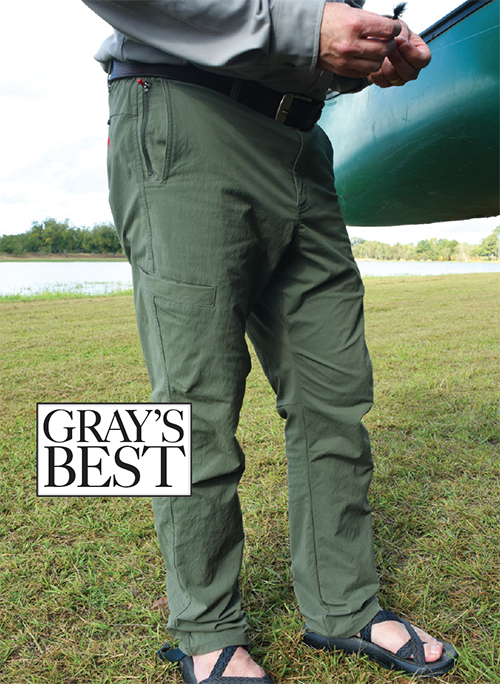
Duck Camp Drifter Pants
This past summer, I tested several pants that had been designed for angling and hot weather. I set simple criteria—comfort, cut, and how quickly they dried. Each pair failed at least one of three categories, and I had just about decided to give this BEST to Swazi for socks that are cut to specific shoe sizes. Then the Drifter pants ($89) from Duck Camp fell into my lap. I tried them on and immediately liked them. They felt like active pants should feel on a grown man, with room to stride. And unlike some of the other pants I tested, they didn’t go too far toward the direction of skinny pants. They fit more like a favored pair of jeans. And during a hunt for marsh hens, I shot a bird that fell beyond the main channel and waded out in thigh- deep brackish water to look for it. Some reasonable time later, the pants were dry enough that I could have walked into my wife’s clean kitchen without getting lectured. That’s saying something. The pants exceeded my expectations in all three criteria—plus the seams are double stitched. They have two pockets with zippers to secure items such as keys and another pair of pockets with magnet closures for oft- used items such as a fly box or a phone. Learning what I didn’t like in a pair of active pants made liking this offering from Duck Camp so very easy. Available in two colors: sandbar and river rock. www.duckcamp.com
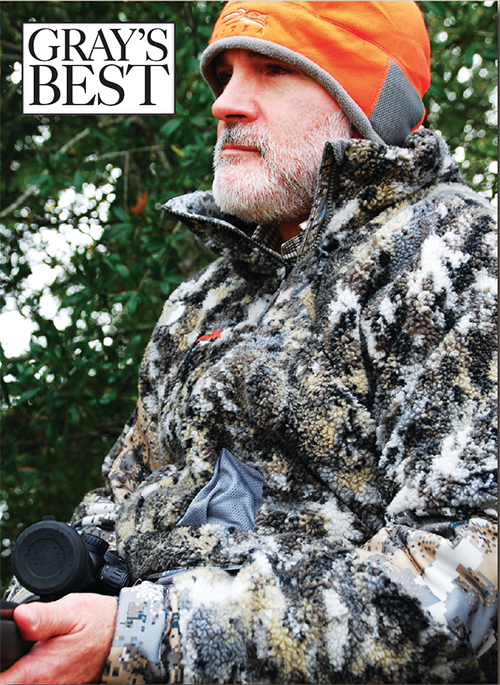
Sitka Gear Fanatic Jacket
A cold day in the coastal plain of Georgia ranges from highs in the low 40s to lows in the mid 20s. Here, the winter of 2019–2020, plagued by warmth, had only five or six such days. Fortunately, three of those days occurred during the Gray’s annual deer hunt. Most of our guests arrived from colder climes—Colorado, Montana, Utah. And we warned them, “We’re gonna have some 25-degree weather. The humidity here will slowly settle into your bones. Don’t underestimate it.” After the hunts each morning, almost to a person, our guests said, “I have never been colder on a deer stand.” Ironically enough, I’d never withstood the cold more comfortably. I give credit to Sitka’s second-generation Fanatic Jacket ($449). And though it’s designed to accommodate the specific needs of bowhunters and silence their movements, it’s also great for rifle hunters who sit long cold, damp hours on a stand. The exterior is a high-loft Berber fleece that al- lows you to draw a bow or shoulder a rifle in near total quiet. The insides include a layer of Gore-Tex Infinium with Windstopper, which Gore describes as “totally windproof, highly breathable,” and for extra warmth, a layer of PrimaLoft Silver Hi-Loft Ultra insulation, which is 60 percent down and 40 percent synthetic fibers. A benefit of being less cold is less squirming. I sat in stands that I’ve sat in many times, but last year, I saw far more deer than usual, including the two finest bucks I’ve ever seen. www.sitkagear.com
Accessories
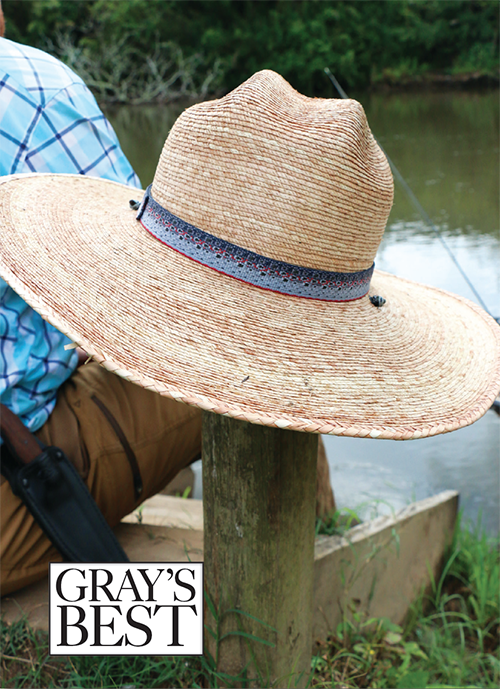
Fishpond Lowcountry Hat
The Fishpond Lowcountry Hat ($60), with its 4½-inch brim and laid-back coastal vibe, may look a bit imposing when you first take it out of the box. And at first glance, your significant other may be hesitant to offer a ringing endorsement of your decision to showcase this resounding testament to the virtues of Guatemalan palm. You’re going to need a certain amount of swagger to pull this off. But there are some things that matter on the trout stream or casting platform that don’t much matter anywhere else. Things like giving your eyes the perfect shade when you’re staring into a deep pool for a big brown trout. Or keeping the glare at bay while you scope the shallows to find a moving target on the bonefish flat. Things like keeping sun off your head, neck, and face (50 SPF) on a blistering summer day, then protecting you from the driving rain when an afternoon storm blows through, leaving you all alone on the river an hour later to match a hatch that nobody else stuck around to see. It’s the kind of hat that makes other fly fishermen take a look at you and think, Well, if he’s got the stones to walk around wearing that, then he must really know what he’s doing. Or, perhaps, it is simply the hat you wear when you don’t care one bit about what anybody else thinks, because first and foremost, you’re here to catch fish. www.fishpondusa.com
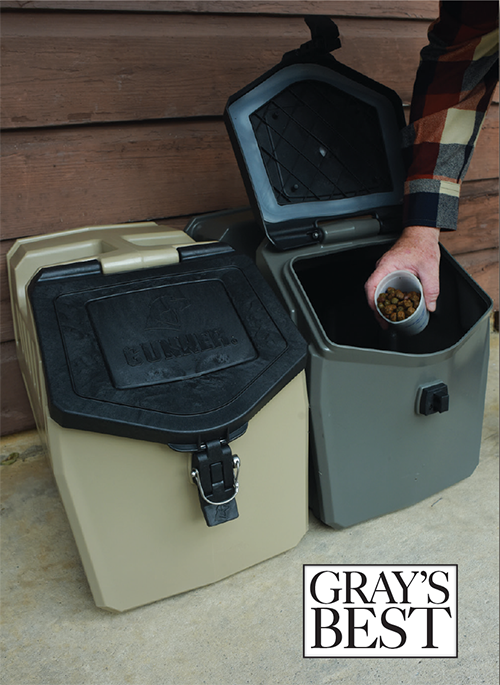
Gunner Kennels Food Crate
Four out of four raccoons can’t be wrong. When the Gunner Kennels Food Crate ($250) arrived on our doorstep, we immediately put it to the test by filling it to capacity (50 pounds or 11½ gallons) with dog chow before setting it beside the deer feeder, where an enterprising family of trash pandas proved ever-so-curious. Five days later, they still hadn’t cracked the code. Next we placed the crate in a pile of fire ants, where a full week of exposure to the omnivorous menace left them stymied. But is it watertight? Three days of sitting outside in the remnants of a Gulf hurricane left Cooper’s dog food fresh and dry. We’re sold. Built with the same rotomolded toughness as Gunner’s G1 kennel series, the food crate has a highly durable nylon lid, an airtight thermoplastic rubber seal gasket, an IPX7 waterproof rating, and a stainless steel locking pin. It’s also portable, with a well- balanced handle that makes for easy lifting, pouring, and carrying. Raised rubber feet that prevent sliding while elevating the crate from hot or cold surfaces complete a package that succeeds in solving virtually any dog-food storage problem you’ve ever had. www.gunnerkennels.com

Stone Glacier Chilkoot 15° Sleeping Bag
At some point, most outdoorsmen have retired to a sleeping bag that is some combination of too short, too narrow, too heavy, too cold, or in some other way unsatisfactory. I recently gave up on my favorite sleep sack, for instance, because it sprayed a mist of synthetic insulation each time I rolled over—the seemingly microscopic source of which remains shrouded in mystery. So when I crawled into the ultralight down Chilkoot 15° ($549) from Stone Glacier, I was hard-wired to be unimpressed. And oh how wrong I was. The Chilkoot series (also available in 0°) is designed for backpack hunters who go deep into the wilderness, so you know it’s going to be lightweight with premium packability. But the bag excels in areas where others fail, including remarkable comfort thanks to an anatomically shaped 18-inch footbox along with differential patterning that maintains a consistent layer of loft, regardless of sleep position. The bag is broad at the shoulders, with a 32-inch width that closes tight to hold in heat via an insulated neck cuff with elastic and magnetic closure. And while we hesitate to say any sleeping bag is truly waterproof, the Chilkoot, with its HyperDry insulation and a Pertex Quantum shell that protects the 850+-fill water- resistant goose down, is mighty close. Which is really just a fancy way of saying we vigorously sprayed the bag with a water hose, then climbed inside to find it remained bone dry and snug. www.stoneglacier.com

Benchmade Meatcrafter Knife
With society’s ever-increasing emphasis on sustainable, farm-to-table organic culinary options, it was only a matter of time before hunters sought a more efficient way to process quarry into table fare. Perhaps no outdoorsman has been a more prominent advocate for knowing where our protein comes from, along with how to prepare it for the grill or pan, than Steven Rinella, originator and host of the television show MeatEater. So when Benchmade set out to create a knife designed to better process wild game into steaks, stew meat, and roasts, it knew where to go. Their collaboration resulted in the Meatcrafter ($300), a fixed-blade masterpiece that does many things well but truly excels as a butchering and kitchen knife. It’s perfect for working around bone and joints thanks to a 14-degree edge angle, while its scimitar shape proves ideal for long slicing (and if you happen to share our passion for tomato sandwiches, it will segment a vine-ripened tomato into paper-thin perfection). Yet it maintains just the right amount of flex for opening cuts and precision work, with backbone enough to easily carve through ribs or heavy cartilage. True, there’s an abundance of knives well suited for the dirty work most often done in the field, but when it comes to prepping your game for the table, you won’t find a better tool for the task than the Meatcrafter. It may prove to be the last kitchen knife you ever need to buy. www.benchmade.com
Vintage & Editor’s Choice

LL Bean Maine Hunting Shoe
Where I grew up, people wore duck boots to keep their feet warm and dry during adverse conditions on the farm or in the field. So you can imagine my surprise when I went to college and saw fraternity boys wearing them to class and around town—on sunny days. I never embraced the casual use of the duck boot, wearing them primarily during rainy deer hunts or dove shoots. Today, there are many manufacturers of duck boots, but there is only one original: the L.L.Bean Maine Hunting Shoe ($149). Leon Leonwood Bean designed the boots in 1911 and began selling them in 1912 via flyers he mailed to hunters who visited Maine from other states. The Maine Hunting Shoe was the first item ever to be sold under the L.L.Bean banner and is the foundation of the company. Very little, if anything, has changed in the shoe’s original design and construction—the soles and bodies are made of rubber and are hand stitched to genuine leather uppers. That’s it. These days, you can get the boots lined with flannel or some other cozy material. For me, the originals are just fine, as they still protect your feet from the elements. And similar to the original, the boots today include a person- al touch. My most recent pair arrived with a note that read in typeface “Handcrafted for you by” . . . and then in handwritten cursive, Linda. www.llbean.com
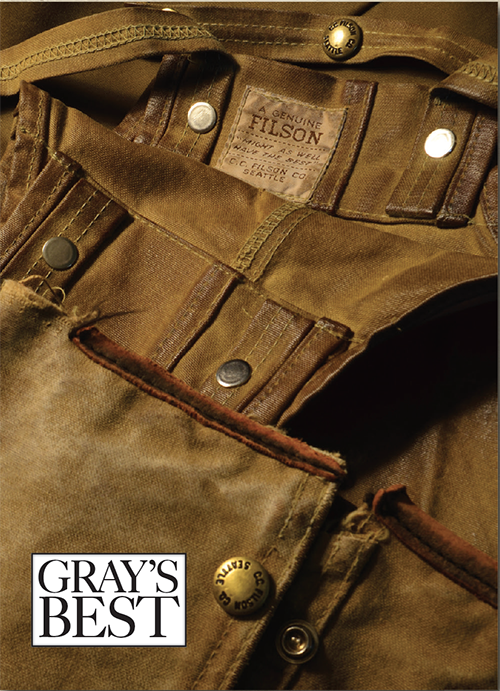
Filson Tin Cloth Chaps
Old-fashioned they may be, but invaluable they undoubtedly are: Filson’s venerable tin cloth chaps ($115)— heavy oiled cotton that defies belief in strength and longevity—belong in everyone’s wing shooting kit. In the 1990s, I bought a pair and loved them; a decade later, I bought another pair in case the first ones wore out. I’m still wearing the originals because they never wore out. They became scratched, worn, and punctured in places; interestingly, the leather trim along the bottoms has worn and torn more than the tin cloth. That tells you something. Filson chaps fit over any pants you care to wear. They shed water, for plowing through long, wet grass; they repel briars like iron; when it’s cold, you can wear your normal pants and the chaps are windproof and warm. At the same time, with light pants, they are not too hot in warmer weather. They go on and off over your boots, which is convenient. A good friend kept buying the latest and greatest from other makers, usually in the form of all-in-one pants that never seemed to work as billed. Finally, he bought a pair of Filsons (grudgingly admitting his error) and has never looked back. Be warned, however: showing up at a shoot in brand-new Filson chaps marks you as either a newcomer, a shooter who has belatedly come to his senses, or someone who has managed to wear out his originals. How you present it is up to you. www.filson.com

Maxima Ultragreen Tippet
There are so many things that can still go wrong, even if you are lucky enough to hook a Northwest steelhead these days, that few anglers I know are willing to stray far from anything that has worked for them in the past. I was a fan of Maxima Ultragreen (27-yard leader wheels $4.50–$6.50, de- pending on test) before I moved north or even carried a fly rod into the Baja surf; no matter how frequently I crossed the border, I would always refill my Penn Jigmaster with fresh 20-pound “green Maxima”—better for hurling heavy spoons and chrome jigs beyond the surf. Steelhead leaders and tippets present their own vagaries and challenges. Mostly I want material I can trust—especially after all the casting that often precedes the next fish. Monofilament, of course, is practically buoyant, ideal for surface presentations. Made of nylon, mono also stretches, which can make the difference with heavy fish. The drawback to Maxima (or any mono) is that it doesn’t age well; UV light will eventually cause it to grow brittle, undermining its stretch and breaking strength. But in my mind, only a foolish steelheader begins a day—or even a session—on the river without first replacing his or her tippet. Once I knot a fly to a fresh length of 12-pound Maxima, I enjoy a rare moment of confidence, certain that at least that won’t go wrong. www.maximafishingline.com
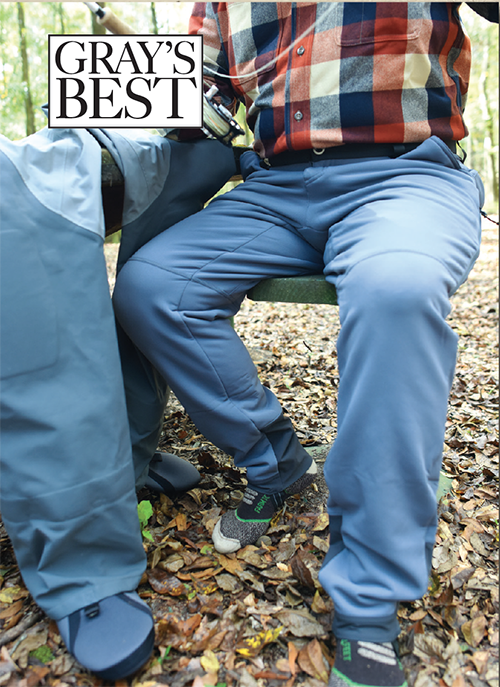
Orvis Pro Underwader Pants
Deer camp, rural Georgia, January of last year. Bad weather is moving in fast, and my long johns are resting comfortably, warm, and cozy atop my bedroom dresser, nearly two hours away. Temperatures in the low 20s, paired with a biting northeast gale, promise to make for a miser- able morning on the stand. Thankfully, just when my frigid fate seemed sealed, I found my Orvis Pro Underwader Pants ($139) cloistered in the back of my SUV, unused and largely forgotten after an uncommonly warm trip to the mountains a few months prior. Disaster averted. Come to think of it, not only was it averted—things were actually rather toasty up there, thanks to the garment’s heavy fleece interior, two hand-warming front pockets, and a tapered fit that prevented bunching in areas that might have otherwise proved vulnerable to the elements. Months later, the pants proved equally adept at doing what they were actually designed to do, which is fit comfortably beneath a pair of breathable waders for extra insulation when things get chilly in the water. There’s a full elastic waist band with belt loops, along with zip mesh side vents for increased ventilation. Plus, they’re easily washable. Behold, a garment that performs with ease both its assigned task and a last-second improvisation under highly adverse conditions. That makes it a Gray’s Best winner. www.orvis.com
